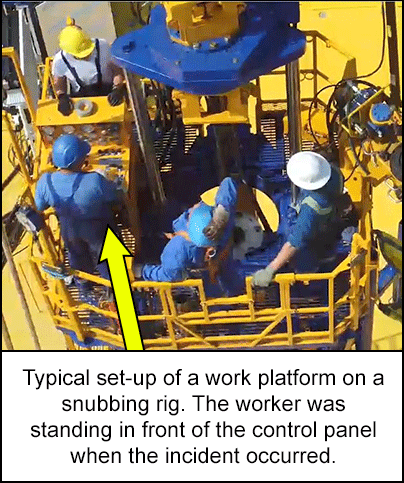-
What happened?
Snubbing units are used for fishing, milling, drilling, side tracking or any task needed to remove bridge plugs, cement or deepen wells while the well remains live. Snubbing is a high hazard activity.
During snubbing activity, a worker was running diagnostics, but the equipment was not locked out. The worker was struck and killed when the equipment fell from a suspended position.

-
Why did it happen?
- Controls were not locked out.
- Jack and tubing were not secured by moving into downward position.
- The well was not secured when performing diagnostics.
- No hazard assessment was conducted before performing diagnostics.
Contributing factors:
The traveling assembly fell without an energized hydraulic power unit when trapped pressure in the lift pilot line released. The self-contained hydraulic control system— Hydraulic Work Over (HWO) unit ceased keeping pressure against the jack, causing the jack cylinder to drop suddenly.
The company confirmed, through thorough testing, that it was possible for the worker-operated pilot valve to unintentionally move due to the traveling assembly’s own weight. In this case, the equipment fell, striking the worker standing beneath it.

-
What did they learn?
As a corrective measure, the manufacturer installed a counterbalance valve as close to the worker-operated pilot valve as possible to prevent unintentional equipment movement. The counterbalance valve activates even when there is catastrophic hydraulic failure.
Additional resource:
* Different regulations covering snubbing equipment may apply depending on your country/region.
DACC IRP #15 - Snubbing Operations (Canada)
Lockout Equipment (Section 15.3.1.7)
- A lockout system shall be in place to prevent equipment failure where there is potential for workers to be injured while they are inside the range of motion of that equipment.
- Snubbing unit components that shall have lockouts include, but are not limited to, the following:
- Power Tongs
- Slip Controls
- Snubbing BOP Controls
- Jack Control
- Annular
Engineering and Design Specifications (Section 15.3.3)
- All snubbing equipment in use must be certified by a certified professional engineer using the appropriate and applicable standards from the following:
- American National Standards Institute (ANSI)
- American Petroleum Institute (API)
- American Society of Mechanical Engineers (ASME)
- Canadian Standards Association (CSA)

-
Ask yourself or your crew
- How can something like this happen here (e.g. on our site)?
- What safety measures (i.e. procedures, controls/barriers) do we have in place to mitigate the risk?
- How do we know the risk controls/barriers are working?
- What improvements or changes should we make to the procedures, controls/barriers or the way we work?

Add to homescreen
Content name
Select existing category:
Content name
New collection
Edit collection
What happened?
Snubbing units are used for fishing, milling, drilling, side tracking or any task needed to remove bridge plugs, cement or deepen wells while the well remains live. Snubbing is a high hazard activity.
During snubbing activity, a worker was running diagnostics, but the equipment was not locked out. The worker was struck and killed when the equipment fell from a suspended position.

Why did it happen?
- Controls were not locked out.
- Jack and tubing were not secured by moving into downward position.
- The well was not secured when performing diagnostics.
- No hazard assessment was conducted before performing diagnostics.
Contributing factors:
The traveling assembly fell without an energized hydraulic power unit when trapped pressure in the lift pilot line released. The self-contained hydraulic control system— Hydraulic Work Over (HWO) unit ceased keeping pressure against the jack, causing the jack cylinder to drop suddenly.
The company confirmed, through thorough testing, that it was possible for the worker-operated pilot valve to unintentionally move due to the traveling assembly’s own weight. In this case, the equipment fell, striking the worker standing beneath it.
What did they learn?
As a corrective measure, the manufacturer installed a counterbalance valve as close to the worker-operated pilot valve as possible to prevent unintentional equipment movement. The counterbalance valve activates even when there is catastrophic hydraulic failure.
Additional resource:
* Different regulations covering snubbing equipment may apply depending on your country/region.
DACC IRP #15 - Snubbing Operations (Canada)
Lockout Equipment (Section 15.3.1.7)
- A lockout system shall be in place to prevent equipment failure where there is potential for workers to be injured while they are inside the range of motion of that equipment.
- Snubbing unit components that shall have lockouts include, but are not limited to, the following:
- Power Tongs
- Slip Controls
- Snubbing BOP Controls
- Jack Control
- Annular
Engineering and Design Specifications (Section 15.3.3)
- All snubbing equipment in use must be certified by a certified professional engineer using the appropriate and applicable standards from the following:
- American National Standards Institute (ANSI)
- American Petroleum Institute (API)
- American Society of Mechanical Engineers (ASME)
- Canadian Standards Association (CSA)
Ask yourself or your crew
- How can something like this happen here (e.g. on our site)?
- What safety measures (i.e. procedures, controls/barriers) do we have in place to mitigate the risk?
- How do we know the risk controls/barriers are working?
- What improvements or changes should we make to the procedures, controls/barriers or the way we work?
A worker lost his life when the equipment, not properly locked out, fell from a suspended position while he was running diagnostics. To prevent similar accidents, ensure that all controls are properly locked out, secure the jack and tubing in a downward position, and conduct a thorough hazard assessment before performing diagnostics.
Original material courtesy of Energy Safety Canada














